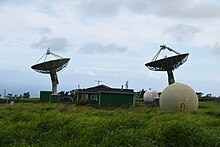Swedish Space Corporation
This article needs additional citations for verification. (August 2014) |
 | |
| Type | Government-owned |
|---|---|
| Industry | Space |
| Founded | 1972 in Solna, Sweden |
| Headquarters | Solna , Sweden |
Key people | Stefan Gardefjord, CEO |
Number of employees | 506 (2018) |
| Website | www |

The Swedish Space Corporation (SSC) provides space subsystems, space and satellite operations, rocket and balloon systems including experiment equipment, launch services, aerospace engineering services as well as airborne maritime surveillance systems. Through its wholly owned subsidiaries ECAPS and NanoSpace, the SSC is also engaged in the development of propulsion systems and micromechanical systems for space applications.
From its facility Esrange Space Center in Northern Sweden, the SSC launches sounding rockets and high-altitude balloons for research in the areas of microgravity, astrophysics, astronomy and atmospheric studies. One notable program during the late 1980s/early 1990s was a joint project with the using SSC's MASER rocket to lift aloft various experiments requiring microgravity environments, at a low cost. This was during a period when U.S. Space Shuttle flights along with associated planned experiments were still being disrupted by the aftermath of the Challenger disaster.
At Esrange SSC operates one of the world's busiest civilian satellite ground stations, communicating with both telecom and scientific satellites. The SSC's facility Stockholm Teleport provides satellite communication services, and the wholly owned German company LSE is specialised in satellite control and ground station services. The SSC runs a global ground station network, PrioraNet, in which its US subsidiary Universal Space Network plays a big part.[citation needed]
On 1 July 2011, the SSC sold its satellite division to the German space company OHB which then formed a Swedish subsidiary named OHB-Sweden.
In February 2013, a government audit was released by the Swedish National Audit Office which concluded that "Swedish space investment is distributed among multiple organizations that operate as stovepipes with no real communication between them and no common ambition."[2] While approximately 1 billion SEK (158 million USD) is spent each year on Swedish space initiatives, the audit report calls for additional "government oversight of the European Space Agency (ESA) and a review of the Swedish Space Corporation's structure and mission."[2]
The SSC announced on 21 September 2020 that it was not renewing its contract to help operate Chinese satellites from its ground stations, and that it would cease doing business in China altogether.[3]
Scientific satellites developed[]
- Prisma satellites – launched 15 June 2010
- SMART-1 – launched 27 September 2003
- Odin – launched 20 February 2001
- Astrid 2 – launched 10 December 1998
- Astrid 1 – launched 24 January 1995
- Freja – launched 6 October 1992
- Viking – launched 22 February 1986
Telecom satellites project management[]
Other locations[]
SSC Ground Station Network:
- Yatharagga Satellite Station – SSC Space Australia
- Esrange Satellite Station at Esrange Space Center
References[]
- ^ SOUTH POINT SATELLITE STATION
- ^ Jump up to: a b "Report Calls for Sweeping Rethink of Swedish Space Spending". Space News. 14 February 2013. Retrieved 22 March 2013.
- ^ "Swedish space agency halts new business helping China operate satellites". Reuters. 21 September 2020. Retrieved 23 September 2020.
External links[]
- Swedish Space Corporation – Official website
- OHB Sweden – Official website
- SSC Ground Station Network
- 1972 establishments in Sweden
- Technology companies established in 1972
- Government-owned companies of Sweden
- Scientific organizations based in Sweden
- Defence companies of Sweden
- Aerospace companies of Sweden
- Space programme of Sweden
